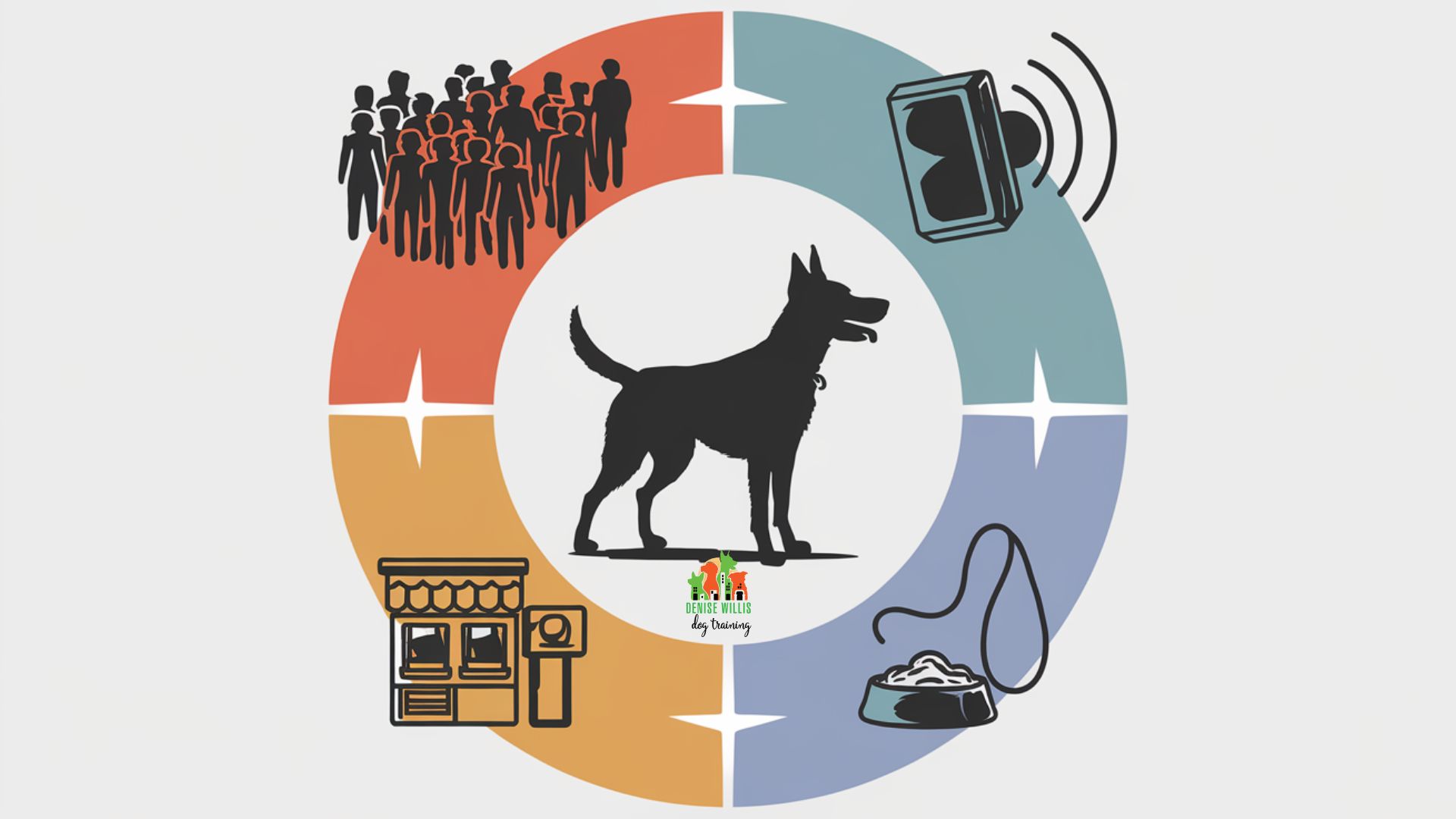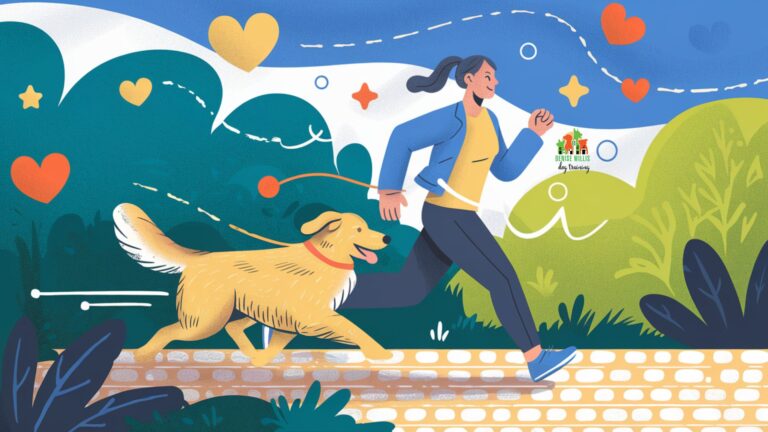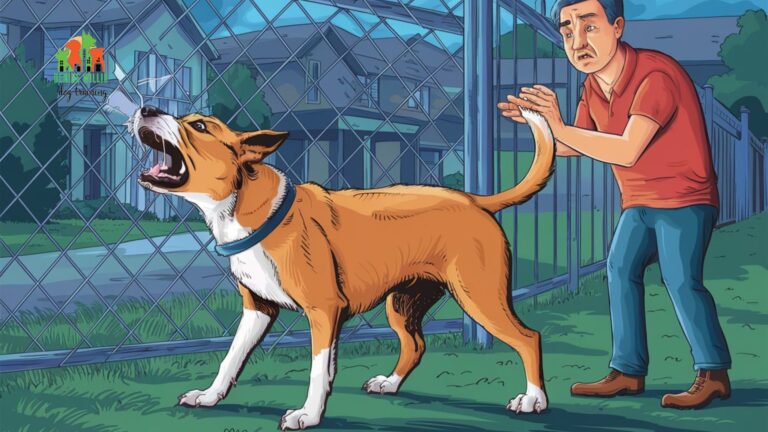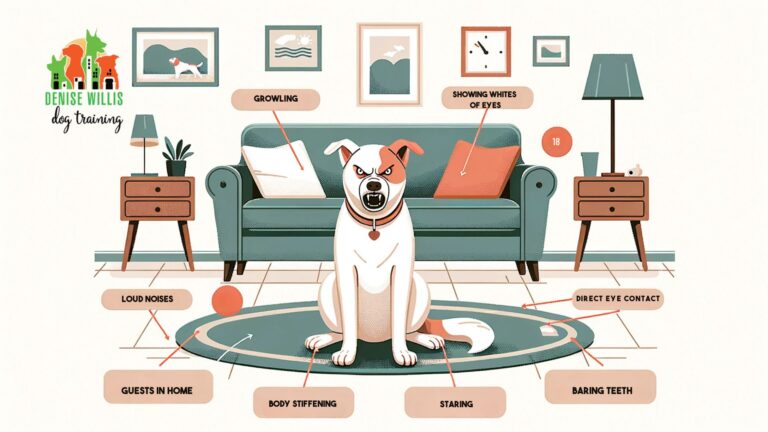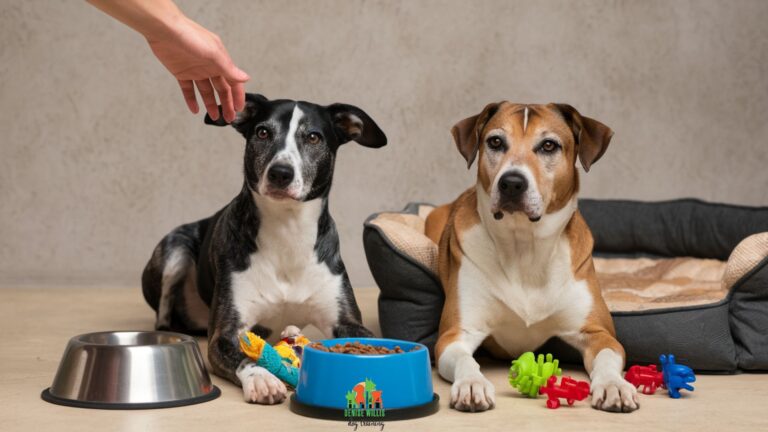Identifying and Managing Environmental Triggers for Dog Aggression
📍 Service Area Notice: DW Dog Training provides in-person training services exclusively in the Greater Baltimore area. While our blog content is designed to help dog owners internationally, our hands-on training services are locally focused. For readers outside our service area, we hope you find value in our articles and welcome you to reach out with questions!
Your sweet pup who normally snoozes on the couch suddenly starts growling at the mailman. That friendly dog park regular now bares teeth when another dog approaches their favorite ball.
Sound familiar?
Dogs, much like humans, react to their environment in complex ways. Sometimes these reactions manifest as aggression – not because they’re “bad dogs,” but because something in their environment has triggered a defensive response. According to research published in Scientific Reports, understanding these triggers isn’t just fascinating behavioral science; it’s essential knowledge for every dog owner.
Recent studies show that environmental factors play a major role in canine aggressive behaviors.
The good news?
Once we understand these triggers, we can help our four-legged friends navigate their world more confidently.
Understanding the Basics of Environmental Triggers
Think of your dog’s brain like a sophisticated security system – always scanning for potential threats or stressors. Sometimes this system gets a little too enthusiastic about its job, kind of like that overachieving smoke detector that goes off when you’re just making toast.
Early Life Experiences Matter
Those first few months of a puppy’s life?
They’re basically writing the blueprint for how they’ll react to the world forever. Scientists have found that dogs who missed out on proper socialization during their critical period (that’s between 4 to 14 weeks of age) are more likely to react with fear-based aggression later in life. It’s like sending someone into a foreign country without any language lessons. everything seems potentially threatening because nothing feels familiar.
The Numbers Behind the Barks: Understanding Dog Aggression Statistics
Ever wondered if your reactive rover is part of a bigger picture? Well, grab your calculator and a coffee (or maybe something stronger) because these numbers might surprise you! While every dog is unique – like snowflakes with fur and opinions about the mailman – science has given us some fascinating insights into canine aggression patterns.
Think of this as your cheat sheet for understanding the scope of doggy discussions-gone-wrong. And remember, these aren’t just numbers – they’re stories of real dogs and their humans navigating the complex world of canine communication.
| Behavior Type | Percentage | Notes | Source |
|---|---|---|---|
| Problem Behaviors | 72.5% | Dogs showing highly problematic behavior | [7] |
| General Aggression | 14% | Dogs exhibiting aggressive behavior | [7] |
| Family-Directed Aggression | 6% | Dogs showing aggression toward family members | [7] |
| Defensive Aggression | 53.8% | Percentage of defensive aggressive incidents | [3] |
| Offensive Aggression | 30.8% | Percentage of offensive aggressive incidents | [3] |
| Single Bite Incidents | 76.5% | Aggressive dogs that bit once during reported events | [3] |
Mind-opening, isn’t it?
These statistics tell us something crucial. If you’re dealing with an aggressive dog, you’re not alone in this journey. In fact, you’re part of a pretty big club (though perhaps not one you were eager to join!).
The good news? Understanding these patterns helps us become better advocates for our four-legged friends.
Remember, though, your dog isn’t just a statistic. They’re your personal security system, cuddle provider, and occasional food vacuum, all rolled into one furry package. These numbers simply help us understand the bigger picture while we work on our individual puzzle pieces.
Common Triggers in Daily Life
Before diving into specific triggers, let’s acknowledge something important: every dog is unique. Just as some humans can’t handle horror movies while others binge-watch them for fun, dogs have individual tolerance levels for different environmental stressors.
The Crowd Factor
Remember that time you felt overwhelmed at a packed concert?
Dogs get that feeling too. Studies have shown that crowded or overwhelming situations can trigger aggressive responses in dogs. It’s not because they’re being difficult. they’re literally feeling surrounded and need an escape route.
The Sound of Trouble
Imagine that you’re peacefully sleeping when your neighbor decides 3 AM is the perfect time to start their heavy metal career.
Your startled reaction?
That’s exactly how dogs feel about unexpected loud noises. Research indicates that sudden or persistent loud sounds can flip that internal “fight or flight” switch, leading to defensive aggression.
Size Matters (But Not How You Think)
Here’s a plot twist that might surprise you.
Those tiny dogs with their big attitudes aren’t just being dramatic. Scientific studies reveal that small dogs actually have higher odds of showing aggressive behavior than their larger cousins. Think of it like this: if you were coffee-table-sized in a world of giants, you might feel a bit defensive too!
The overall stress levels and reactions to environmental triggers often have more to do with how secure a dog feels in their environment than their actual size.
Speaking of feeling secure…
The Resource Guardian
Remember how possessive you felt about your lunch when that one coworker kept eyeing it in the break room?
Dogs get that same feeling about their valued possessions. Expert behaviorists note that resource guarding isn’t just about being “mean”. It’s a deeply ingrained survival instinct.
The Big Picture: Your Guide to Dog Aggression Triggers
Before we dive deeper into the nitty-gritty details (or should I say the “bitey-gritty”?), let’s take a look at the key players in the drama of doggy disagreements. Think of this as your cheat sheet for understanding what makes your furry friend go from “tail wags” to “tail red flags”!
Understanding Dog Aggression Triggers
Early Life Impact
Those crucial puppy weeks (4-14) are basically doggy college – what they learn (or don’t!) shapes their future reactions to the world. Missing this window? It’s like sending your pup to life’s party without teaching them the social dance moves!
Environmental Stressors
Remember how you feel in a crowded elevator? That’s your dog at every busy dog park. Add some unexpected fireworks or a surprise skateboard, and suddenly your brave buddy might need their emotional support human!
Physical Factors
Ever been hangry or had a headache that made everything worse? Your dog gets it! Physical discomfort can turn your usually chill canine into a cranky companion faster than you can say “vet appointment.”
Emotional Connection
Dogs are like furry emotional sponges – they soak up your stress faster than your favorite sweatpants absorb coffee stains. Your anxiety is their anxiety, your calm is their calm!
See what I mean about these triggers?
They’re like pieces of a puzzle that, when put together, help us understand why our furry friends sometimes hit their limit. Just remember, understanding these triggers isn’t about making excuses; it’s about finding solutions that work for both ends of the leash!
The Hidden Influence: Your Emotional State
If you’ve ever had a rough day at work and noticed your dog acting a bit off, you’re not imagining things. Dogs are emotional sponges with a PhD in human body language. Studies show that your anxiety, fear, or stress can directly influence your dog’s behavior and potentially trigger aggressive responses.
Physical Well-being and Behavior
Just like humans aren’t at their best when fighting a headache, dogs dealing with physical discomfort might have a shorter fuse. Medical research confirms that health issues can significantly lower a dog’s tolerance for environmental stressors. Think of it as their emotional battery running on low. Everything takes more energy to process.
Moving Forward: Management Strategies
Before we dive into solutions, let’s acknowledge something important: managing environmental triggers isn’t about creating a perfect, stress-free bubble (though wouldn’t that be nice?). It’s about understanding and adapting to your dog’s unique needs.
The Exercise Solution
Remember that feeling after a good workout when even your annoying neighbor’s lawn ornaments don’t bother you as much?
Dogs experience something similar. Research published shows that dogs getting less than one hour of daily exercise have a higher probability of developing stress-related behaviors. It’s like giving your dog a natural chill pill – minus the actual pill part!
Creating Safe Spaces
Just like you might need your quiet corner after a long day of meetings, dogs need their own retreat when the world gets overwhelming. Expert trainers emphasize that having a designated safe space isn’t spoiling your dog.
It’s giving them the emotional equivalent of a pause button.
Imagine your dog has their own cozy corner where the chaos of daily life can’t reach them. Maybe it’s a covered crate decorated like a canine penthouse, or a quiet spot behind your favorite armchair.
The key is consistency and accessibility.
The Power of Positive Training
Before we get into specific training techniques, let’s bust a myth. Working with an aggressive dog doesn’t mean you need to become the neighborhood’s toughest trainer.
In fact, quite the opposite!
The Science of Reward-Based Training
Remember how quickly you learned to make coffee when your morning happiness depended on it?
Dogs operate on similar principles. Professional trainers have found that positive reinforcement techniques create lasting behavior changes by building positive associations with previously triggering situations.
Think of it as rewiring your dog’s emotional GPS. Instead of “DANGER! DANGER!” flashing at the sight of the mail carrier, they start thinking “Oh cool, that person means treats might happen!”
Age and Behavior: The Time Factor
You know how some of us get a bit grumpier as we age?
(No judgment. Those kids really should stay off your lawn!) Dogs go through similar changes. Research shows that the probability of aggressive behavior actually increases with age. But before you start worrying about your senior pup turning into a cranky old-timer, remember that understanding this pattern helps us adapt our management strategies.
The Fear Factor
Here’s a statistic that might make you sit up straighter: Studies indicate that highly fearful dogs have over five times higher odds of showing aggressive behavior compared to their more confident counterparts. It’s like they’re constantly wearing anxiety-colored glasses that make everything look scarier than it really is.
Moving Forward Together
Remember, working with environmental triggers isn’t about creating a perfect, bubble-wrapped world for your dog. It’s about understanding their unique needs and helping them navigate our human world with confidence.
Think of it like being your dog’s personal translator for the human world. Sometimes things get lost in translation, but with patience, understanding, and maybe a few extra treats, you’ll get there together.
Just like Rome wasn’t built in a day, your dog’s response to environmental triggers develops over time. Click through each stage to see how these behaviors evolve and what you can do to help your furry friend navigate their world more confidently!
The Journey of Understanding Dog Triggers
The Early Days (8-16 weeks)
Think of this as your pup’s “college years” – minus the student loans! This critical socialization period is when your dog learns what’s normal and what’s scary. Missing this window is like sending someone to a party where they don’t know the dance moves!
The Teenage Phase (4-12 months)
Welcome to doggy adolescence! Just like human teens, your pup might start questioning everything they’ve learned. Remember those perfect sits? Yeah, now they’re more like “suggestions.” This is when environmental triggers can start showing their teeth (pun intended)!
The Reality Check (1-2 years)
Now we’re seeing who your dog really is! Studies show this is when most behavioral patterns become established. It’s like your dog’s personality has finally finished downloading – and sometimes there are a few bugs to work out.
The Maintenance Years (2+ years)
Just like maintaining your car (but way more fun), this is when consistent training and management become crucial. Research shows older dogs actually have higher odds of showing aggressive behavior, so keeping up with training isn’t just for puppies!
Product Recommendations
So, your dog thinks every strange noise is a sign of the apocalypse? Don’t worry – we’ve assembled a survival kit that would make any doomsday prepper jealous. Here’s our carefully curated collection of anxiety-busting, confidence-building gear for your four-legged stress ball!
- ThunderShirt Sport Dog Anxiety Jacket: Like a warm hug from a very understanding friend, this snug jacket uses gentle pressure to help calm your nervous nellie. It’s basically spanx for your spaniel, but with actual therapeutic benefits! Warning: Your dog may start requesting this for casual Friday meetups at the dog park.
- KONG Wobbler Interactive Dog Toy: Turn mealtime into mind time with this wobbling wonder. It’s like a slot machine for dogs, but instead of losing money, they win kibble! Perfect for redirecting that “everything is terrifying” energy into “everything is delicious” enthusiasm. Caution: May turn your dog into a puzzle-solving genius who starts helping kids with their math homework.
- PetSafe Premier Gentle Leader: Give your reactive rover some steering assistance with this head halter that’s gentler than a butterfly landing on a cloud. It’s like power steering for your power puller! Warning: Your dog might temporarily think they’ve joined a secret society of sophisticated canines.
- Pet Acoustics Pet Tunes: Bluetooth speaker pre-loaded with music specifically designed for doggy ears. Like a spotify playlist for your stressed-out pup, minus the questionable teenage music choices. Caution: Don’t blame us if your dog develops expensive taste in classical music.
- Nina Ottosson by Outward Hound Dog Brick Puzzle: Transform your anxious astronaut into a confident puzzle master with this treat-dispensing brain teaser! Made with durable food-safe materials, this interactive toy features sliding compartments and flip lids that will keep your Einstein-in-fur engaged and mentally stimulated. It’s like giving your dog their own escape room challenge, minus the timer and creepy background music. Warning: Your dog may start writing their own puzzle game reviews on Yelp, demanding more challenging levels and better treat options.
Remember folks, while these products won’t turn your territorial terrier into a zen master overnight, they’re excellent tools for your journey toward calm. Think of them as your dog’s emotional support toolkit – minus the motivational posters!
Further Reading
Think you’ve mastered the art of understanding your dog’s environmental triggers? Hold onto your leash – we’re about to take a deeper dive into the canine psyche with these fascinating reads!
- 10 Warning Signs Your Dog Might Bite and How to Prevent It: Your complete guide to reading your dog’s “please back off” signals before they escalate to “I mean business.” Trust us, it’s more reliable than your weather app!
- Decoding Your Dog: 15 Body Language Signals You Need to Know: Become fluent in tail-wagging dialects and ear-positioning linguistics. Warning: May cause you to start unconsciously tilting your head during conversations.
- How to Manage Your Dog’s Territorial Aggression: Perfect for the pup who thinks they’re the self-appointed CEO of your home security system. Learn how to negotiate better property boundaries!
- Dog Aggression Solutions: A Complete Guide: The ultimate handbook for transforming your reactive rover into a composed canine. Less bark, more zen!
- The Shy Dog’s Guide to Conquering Fear: Help your wallflower blossom into a social butterfly with these genius confidence-building techniques. Because everyone deserves to be the life of the pawty!
Congratulations!
You’re now officially on your way to becoming a dog behavior detective. Just remember – while knowledge is power, treats are still pretty awesome too!
Test Your Canine Knowledge: The Ultimate “Triggers and Tails” Quiz!
Think you’ve got your dog’s behavior all figured out?
Maybe you’re convinced your pup’s occasional grumpiness is just them waking up on the wrong side of the dog bed. Well, grab your favorite treat (human treats, please – we’ll leave the liver biscuits to our four-legged friends) and let’s put your knowledge to the test!
This isn’t just any ordinary quiz. It’s your chance to see if you can really speak “dog.” Don’t worry if you don’t ace it on the first try; even professional trainers once thought a wagging tail always meant a happy dog! (Spoiler alert: Sometimes it’s more complicated than that!)
Are You Fluent in Dog? Test Your Trigger Knowledge!
Frequently Asked Questions About Environmental Triggers For Dog Aggression
Let's tackle some of those burning questions about environmental triggers. You know, the ones that keep you up at night wondering if your dog's sudden vendetta against the garden hose is normal.
Q: Why does my friendly dog suddenly act aggressive in certain situations?
A: Think of your dog like a smartphone - sometimes they get too many notifications at once and need a reset. Behavioral experts explain that even social butterflies can become overwhelmed when their stress bucket gets too full. It's not a personality change; it's a response to their environment hitting overload.
Q: Does my dog's size really affect their likelihood of showing aggressive behavior?
A: Remember that chihuahua at the dog park who thinks they're a wolf? There's science behind that swagger! Research confirms that smaller dogs actually show higher odds of aggressive behavior than their larger counterparts. It's like being the shortest person in a basketball game - sometimes you have to make up for size with attitude!
Q: Can my emotions really trigger my dog's aggressive behavior?
A: Ever noticed how your dog gives you the side-eye when you're stressed about that work deadline? Scientists have found that dogs are emotional sponges, soaking up their owners' anxiety faster than a paper towel on spilled coffee. Your stress can literally become their stress!
Making Peace with Environmental Triggers
Living with a dog who reacts to environmental triggers doesn't mean you're stuck in a permanent game of "dodge the trigger." With understanding, patience, and the right support system, you can help your four-legged friend navigate their world more confidently.
Remember that every dog is unique. What sends one pup into a tizzy might not even register on another dog's radar. The key isn't eliminating every possible trigger (unless you've figured out how to control the weather, in which case, we should talk). Instead, focus on building your dog's confidence and your understanding of their needs.
Your Next Steps
At DW Dog Training, we believe in turning challenges into opportunities for growth. Whether your dog is just starting to show signs of trigger sensitivity or you're looking to fine-tune your management strategies, we're here to help you build a stronger, more confident relationship with your furry friend.
Ready to start your journey toward better understanding and managing your dog's environmental triggers? Contact DW Dog Training today, where every bark is heard and every tail wag matters.
Remember, your dog isn't giving you a hard time. They're having a hard time.
With the right support and understanding, those challenging moments can become stepping stones to a stronger bond between you and your four-legged friend.

